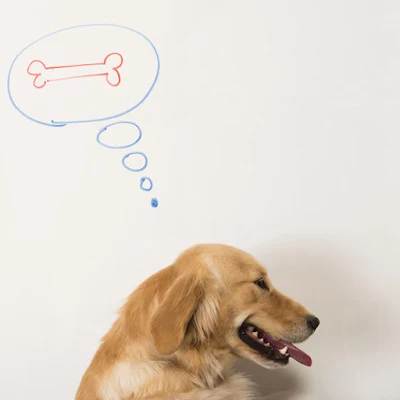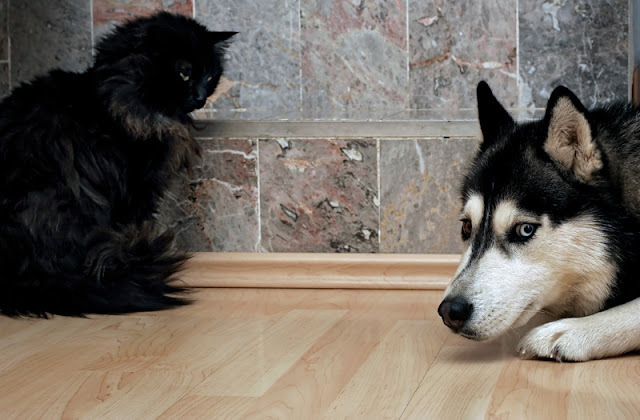The Importance of Food as Reinforcement in Dog Training
Studies show dogs respond better to training when the reward is food.
By Zazie Todd, PhD
This page contains affiliate links which means I may earn a commission on qualifying purchases at no cost to you.
It goes without saying that food is vitally important
and also one of life’s luxuries. Many people
routinely use food such as chicken or treats to train their dogs, while others
are offended by the idea and think their dog should obey commands for praise or affection.
Who is right?
As an Amazon Associate I earn from qualifying purchases.
Several scientists have looked at this topic recently. Last
year we reported on a study by Erica Feuerbacher and Clive Wynne
that compared the use of a food reward to petting and praise in training. In a
series of five studies, they looked at dogs that have owners, dogs that are in
shelters (and hence potentially deprived of affection and petting), and
hand-reared wolves. Amongst all three groups, food was a better motivator than petting
and praise.
One of the striking things about comments on this story was
that some people seemed to confuse food and love; they felt that if your dog
wanted food then it didn’t love you, or didn’t love you enough. But food and
love aren’t mutually exclusive; just because a dog loves sausage doesn’t mean they
don’t also love their family.
In fact, Yuta Okamoto and colleagues in Japan suggest that using the right positive reinforcement in training will ultimately lead to a better relationship with your dog.
Maybe some dogs are more interested in food than others. You know how
some dogs wolf down their food, while others are slower eaters? Okamoto et al
took a group of 34 dogs that lived in a kennel environment. They divided them into those who did not finish a bowl of food
and had leftovers, slow eaters who took their time to finish it, and fast
eaters who finished it quickly.
Then they put the dogs to work, asking them to ‘sit’ every 5
seconds for three 5 minute periods, each time with a short break in between.
They gave a food reward every time the dog sat. Then, for another set of three
sessions, instead of using food, the handler said “good” and stroked the dog if
it sat as requested.
The dogs in the Fast group responded well to food as a reinforcement,
and when the handler switched to praise and petting the rate of response began
to drop off substantially. The group of Slow eaters, on the other hand, did
maintain a good set of responses when the reward was changed to praise and
petting. Finally, the Leftover group was not particularly motivated by either
food or praise and petting.
However, although there were differences between the three groups,
all of the dogs had a better response when food was used as a reward compared
to praise and petting. So this study suggests that although there may be
individual differences in how motivated dogs are by food, they are still all
motivated by food.
While these two studies combined praise and petting, a new
paper by Megumi Fukuzawa and Naomi Hayashi compared food to praise (“Good
boy/girl”) or petting. Fifteen dogs took part; six were pet dogs and nine lived at the university.
They were first given some basic training in a sit/stay. For the experiment, the dogs were divided into three groups according to the type of reinforcement used, and trained to “come” using a standardized plan that had four stages. Only once a dog had completed a stage with 75% of trials correct could it move on to the next stage.
They were first given some basic training in a sit/stay. For the experiment, the dogs were divided into three groups according to the type of reinforcement used, and trained to “come” using a standardized plan that had four stages. Only once a dog had completed a stage with 75% of trials correct could it move on to the next stage.
Dogs came significantly faster when called if they were trained
using food, compared to either praise or petting. In terms of the number of trials needed during the main training, there were fewer differences in reward types.
Interestingly, during the baseline training on sit/stay, which used the same reward as for the experiment, dogs in the food group needed fewer trials than those in the other two groups. The authors suggest that the reward type is most important for the early training sessions.
Interestingly, during the baseline training on sit/stay, which used the same reward as for the experiment, dogs in the food group needed fewer trials than those in the other two groups. The authors suggest that the reward type is most important for the early training sessions.
The design of this study utilized a training plan with
progression once the dog reached a 75% success rate. The dogs required
significantly more sessions to reach the criterion during the first distance of
1m, compared to the following trials at 2m, 3m and 4m. In other words, the
later stages of training were easier.
The authors say that “in training that used 3 types of
reinforcement – food, stroking and praise – it was food that shortened the time
taken to complete the response to the command. However, this difference
occurred only in the early training stages and not later in the training
process.”
One proviso for all of these studies is that the number of
participants is very small. It would be better to use larger numbers of dogs,
especially since there are many different breeds and dogs come into the studies
with different histories of being trained (or not). In research with human
participants, there are guidelines about how many people should take part and
perhaps canine scientists should also begin to use such guidelines in future
research.
However, it is very interesting to note that even with such
small numbers of dogs (and wolves) there is a clear preference for food as reinforcement
in all three studies. Therefore it makes sense to use food in training. For more on this topic, see the ultimate dog training tip.
If you liked this post, check out my book Wag: The Science of Making Your Dog Happy. Modern Dog magazine calls it "The must-have guide to improving your dog's life."
What kind of food is the best motivator for your dog?
References
Feuerbacher, E. N., & Wynne, C. D.
(2012). Relative efficacy of human social interaction and food as
reinforcers for domestic dogs and hand‐reared wolves. Journal of the Experimental Analysis of Behavior, 98(1), 105-129.
Fukuzawa, M., & Hayashi, N. (2013). Comparison of 3 different reinforcements of learning in dogs (Canis familiaris). Journal of Veterinary Behavior, 8(4), 221-224.
Okamoto, Y., Ohtani, N., Uchiyama, H., & Ohta, M. (2009). The feeding behavior of dogs correlates with their responses to commands. Journal of Veterinary Medical Science, 71(12), 1617-1621.
As an Amazon Associate I earn from qualifying purchases.





